Biologics Market Size
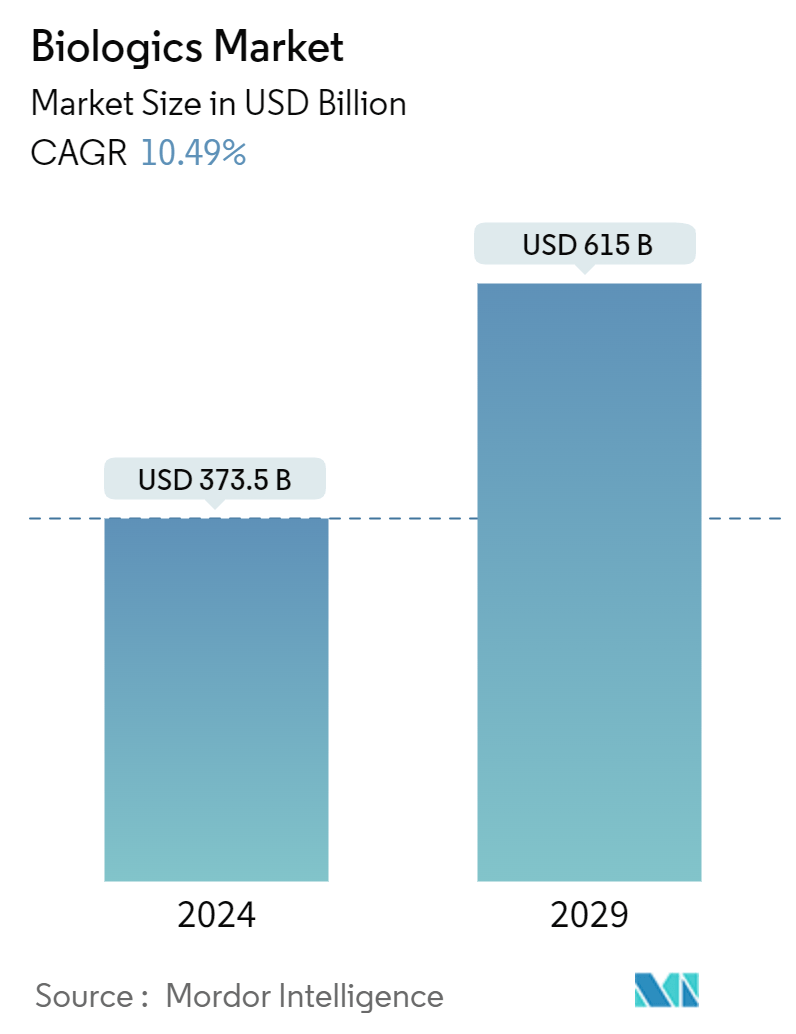
| Study Period | 2019 - 2029 |
| Market Size (2024) | USD 373.5 Billion |
| Market Size (2029) | USD 615 Billion |
| CAGR (2024 - 2029) | 10.49 % |
| Fastest Growing Market | Asia Pacific |
| Largest Market | North America |
Major Players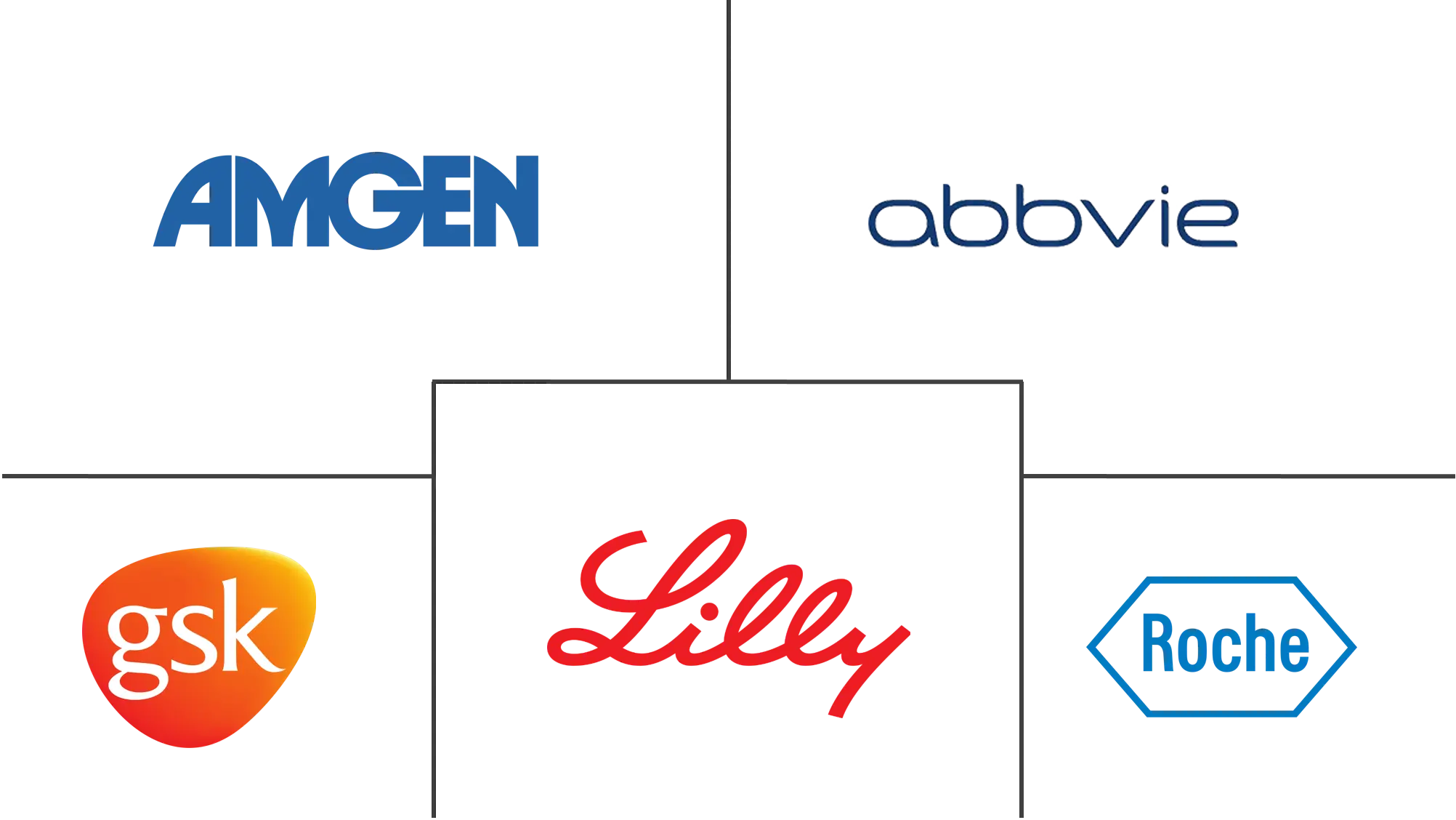
*Disclaimer: Major Players sorted in no particular order |
Need a report that reflects how COVID-19 has impacted this market and its growth?
Biologics Market Analysis
The Biologics Market size is estimated at USD 373.5 billion in 2024, and is expected to reach USD 615 billion by 2029, growing at a CAGR of 10.49% during the forecast period (2024-2029).
The biologics industry is majorly driven by growing capital investment from key players, the rise in the burden of chronic diseases, the loss of patent exclusivity of the leading biologic drugs, and the increasing demand for and higher acceptability of innovative therapies.
According to the WHO report published in September 2023, non-communicable diseases (NCDs) cause 41 million deaths yearly, which is equivalent to 74% of the total death rate. Annually, 17 million individuals succumb to non-communicable diseases (NCDs) before reaching the age of 70, with a substantial 86% of these premature fatalities concentrated in low- and middle-income countries. A predominant 77% of NCD-related deaths occur within the same demographic. The primary contributors to NCD mortality are cardiovascular diseases, claiming 17.9 million lives each year, trailed by cancers (9.3 million), chronic respiratory diseases (4.1 million), and diabetes (2.0 million, including diabetes-induced kidney disease deaths). Collectively, these four disease categories contribute to over 80% of all premature NCD deaths. Factors such as tobacco use, physical inactivity, harmful alcohol consumption, unhealthy dietary practices, and air pollution significantly elevate the risk of succumbing to NCDs. The increasing cases of chronic diseases are expected to increase the demand for biologics further in treating chronic diseases.
The biologics market growth is fueled in part by increased investments. In October 2023, Syngene International, a subsidiary of Biocon Ltd, unveiled an annual investment plan surpassing USD 100 million, focusing primarily on advancing research, biologics, and small molecules. Over the past five years, the company has committed a cumulative investment of approximately USD 54 million (INR 4,500 crores).
Furthermore, in March 2023, Teva made a substantial investment exceeding USD 1 billion in biologics in Europe. Recognizing the escalating demand for biopharmaceutical products, Teva has allocated funds to enhance biologics production technologies, specifically for Active Pharmaceutical Ingredients (APIs) involving cells for biosimilars and novel biologics. Teva's robust pipeline encompasses biosimilars and novel biologic products across various therapeutic areas, and it is poised for delivery to patients in the coming years. At present, biotech products available in the market are manufactured within Teva's biologics production facilities in Ulm, Germany, and Vilnius, Lithuania, as well as through collaborations with external entities in Asia and the US.
In addition, biologics' rising research and development activities support the biologics market's growth. For instance, in March 2023, Catalent signed a licensing agreement with Bhami Research Laboratory (BRL) based in India. This strategic collaboration grants Catalent access to BRL's advanced formulation technology. The primary objective for Catalent is to leverage this technology to facilitate the development of formulations, enabling the subcutaneous administration of high-concentration biologics. This empowers Catalent to engage in collaborative assessments with its clients, exploring the potential of BRL's formulation technology to reduce viscosity and enhance the delivery of high-concentration biologic products. BRL's technology exhibits versatility, applying various monoclonal antibodies and fusion proteins. Successful outcomes from this collaboration may lead to integrating these programs into Catalent's comprehensive formulation and manufacturing services on a larger scale.
Furthermore, biologics product launches by the key market players are anticipated to drive the market's growth. For instance, in July 2023, Biocon Biologics officially announced the availability of HULIO (adalimumab-fkjp) injection, a biosimilar to Humira (adalimumab), for patients in the United States. This milestone follows five years of successful experience with HULIO in Europe and another two years in Canada. The introduction of HULIO to the US market represents a significant expansion of its global presence. It offers patients in the United States access to a well-established and proven biosimilar option.
Moreover, in July 2022, Brii Biosciences Limited, in collaboration with TSB Therapeutics (Beijing) Co. Ltd, a majority-owned joint venture, officially launched the commercial availability of the amubarvimab/romlusevimab combination in China. The release of the initial commercial batch of these long-acting COVID-19 neutralizing antibodies on July 7 signified a significant achievement in advancing the commercialization of this innovative combination therapy.
Thus, the above-mentioned factors are anticipated to drive the biologics industry's growth during the next five years. However, the stringent regulatory processes, high capital investment, and loss of patent exclusivity are likely to restrain the market's growth.
Biologics Industry Trends
The Cancer Segment is Expected to Grow at High Rate in the Application Segment
The cancer burden is increasing globally, and cancer therapies may be modified according to regional and national priorities. Biological therapy for cancer aims to induce the immune system to recognize and kill cancer cells.
Cancer is a formidable global health challenge and stands as a leading cause of mortality. For instance, according to the February 2022 update by the World Health Organization, cancer prevalence is rising at a high rate, and it is evident in the most common types of cancer in terms of new cases and associated fatalities. According to the same source, breast cancer led with 2.26 million new cases, followed closely by lung cancer at 2.21 million cases. Colon and rectum cancer accounted for 1.93 million cases, while prostate cancer and non-melanoma skin cancer contributed 1.41 million and 1.20 million cases, respectively. Stomach cancer was notable, with 1.09 million new cases reported in 2022.
In addition, the above-mentioned report by the World Health Organization also mentioned that approximately 400,000 children annually confront the onset of cancer, with prevalent types varying across different countries. Cervical cancer emerges as the most common pediatric cancer in 23 countries.
Governments of different countries are taking initiatives to increase awareness about cancer and its diagnosis to help people detect cancer early. For instance, in February 2022, the Health Minister of Tamil Nadu, India, stated that the Government of Tamil Nadu is involved in framing the policy to identify 66% of cancer patients in the first and second stages by 2030 to provide proper treatment. Such policies are expected to drive the growth of the segment.
Biologic companies are also continuously focusing on developing novel biologic therapeutics for cancer treatment and are investing in research and development activities. For instance, in May 2022, Biocon Biologics and Viatris (formerly Mylan) launched the cancer drug Bevacizumab under the brand Abevmy in Canada. The Abevmy was developed by the two companies Biologics and Viatris. Hence, the above-mentioned factors contributed to the growth of the cancer segment of the market.
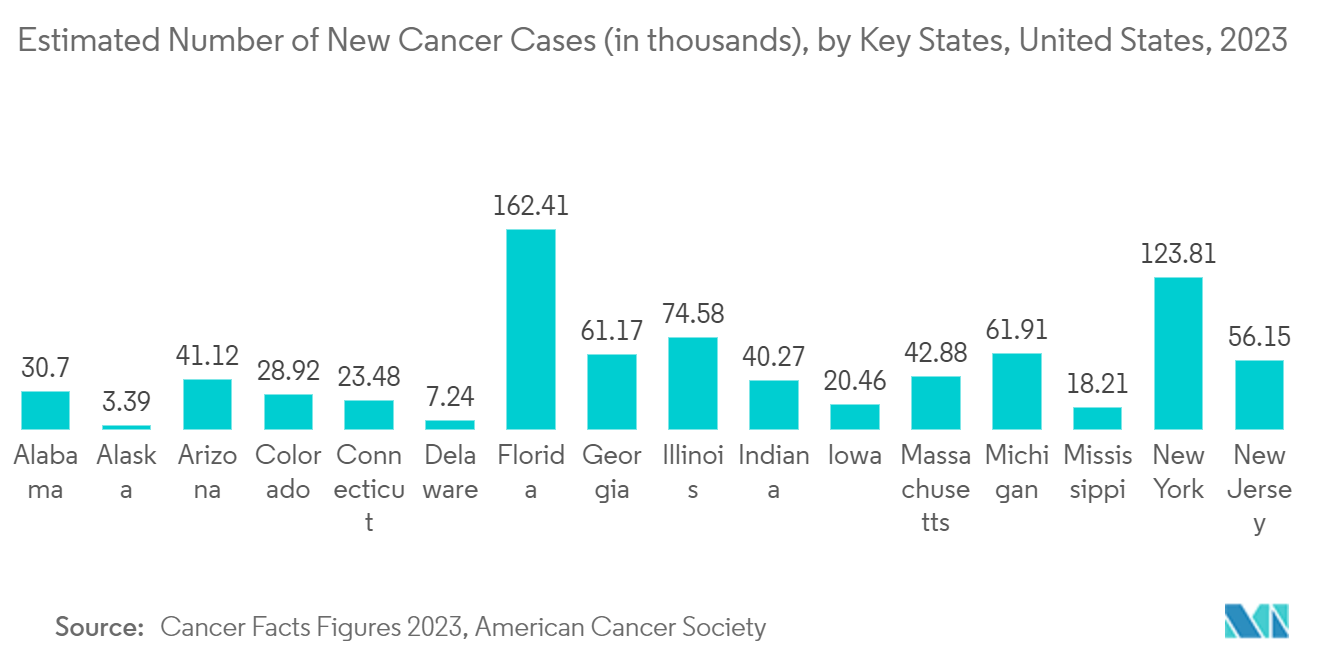
North America Holds the Dominant Market Share Over The Forecast Period
The North American biologics industry dominates the global biologics market, and it is estimated to show a similar trend over the coming years. The primary factors driving the biologics industry are the increasing incidences of chronic diseases, the presence of well-established pharmaceutical companies, and an increase in the number of biotech companies.
According to the American Cancer Society, the United States is estimated to have about 1,918,030 new cancer cases and 609,360 cancer deaths in 2022. Furthermore, according to the National Cancer Institute, the number of cancer survivors is expected to rise to 22.2 million by 2030, up from 17 million in 2020. The most common cancers in the United States are breast, lung, prostate, colorectum, bladder, and skin cancer. Thus, rising cancer prevalence is anticipated to drive the demand for its treatment, thereby boosting the growth of the North America biologics market.
New biological products launched by key players in the market are expected to fuel the market's growth in the United States. For instance, in September 2023, Pfizer Inc. and BioNTech SE disclosed that the U.S. Food and Drug Administration (FDA) approved the supplemental Biologics License Application (COMIRNATY 2023-2024 Formulation) targeting individuals aged 12 years and older. In addition, the FDA has authorized emergency use for individuals aged six months through 11 years for the companies' Omicron XBB.
Therefore, owing to the above-mentioned factors, the biologics industry is anticipated to witness growth in the region over the forecast period.
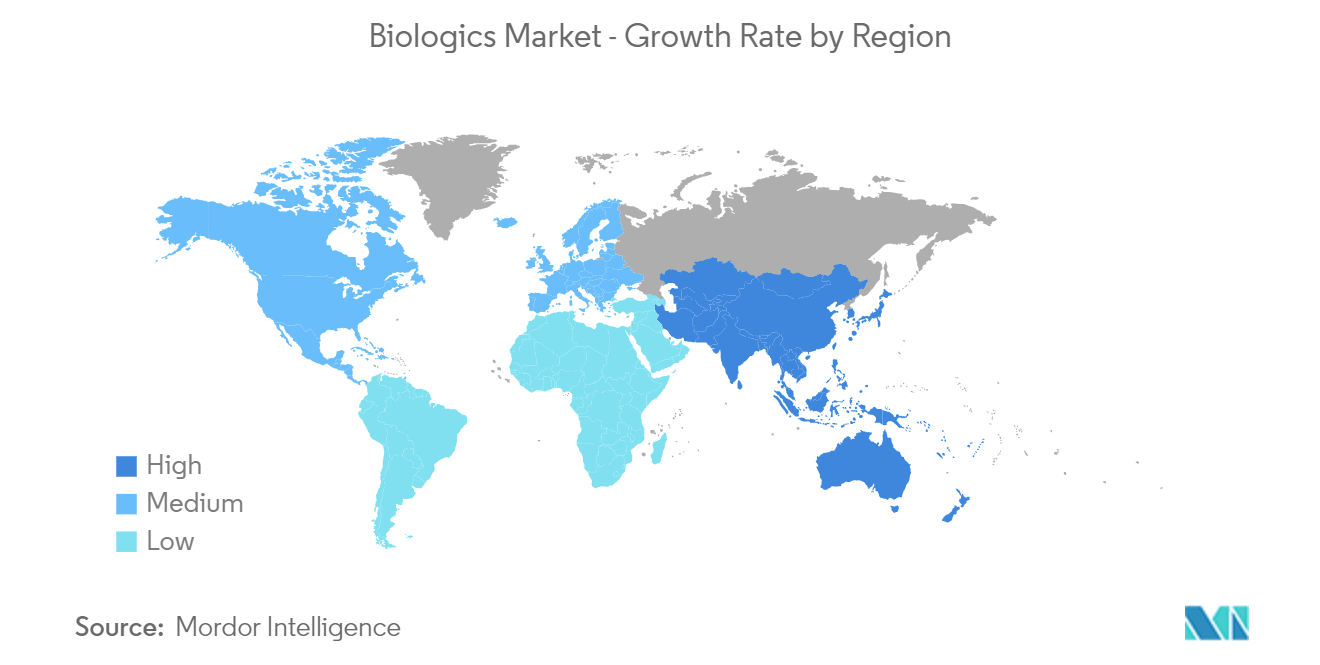
Biologics Industry Overview
The biologics industry is moderately competitive and consists of several major players. Biologic companies are implementing specific strategic initiatives such as mergers, new product launches, acquisitions, and partnerships that help them strengthen their market positions. These companies have made substantial capital investments in the research and development of biologics, as the cost of biologics is relatively high. Some top biologics companies include Amgen, Inc., Eli Lilly and Company, GlaxoSmithKline PLC, Abbvie Inc., and F. Hoffmann-La Roche AG.
Biologics Market Leaders
-
Amgen, Inc.
-
Eli Lilly and Company
-
GlaxoSmithKline PLC
-
Abbvie Inc.
-
F. Hoffmann- La Roche AG
*Disclaimer: Major Players sorted in no particular order
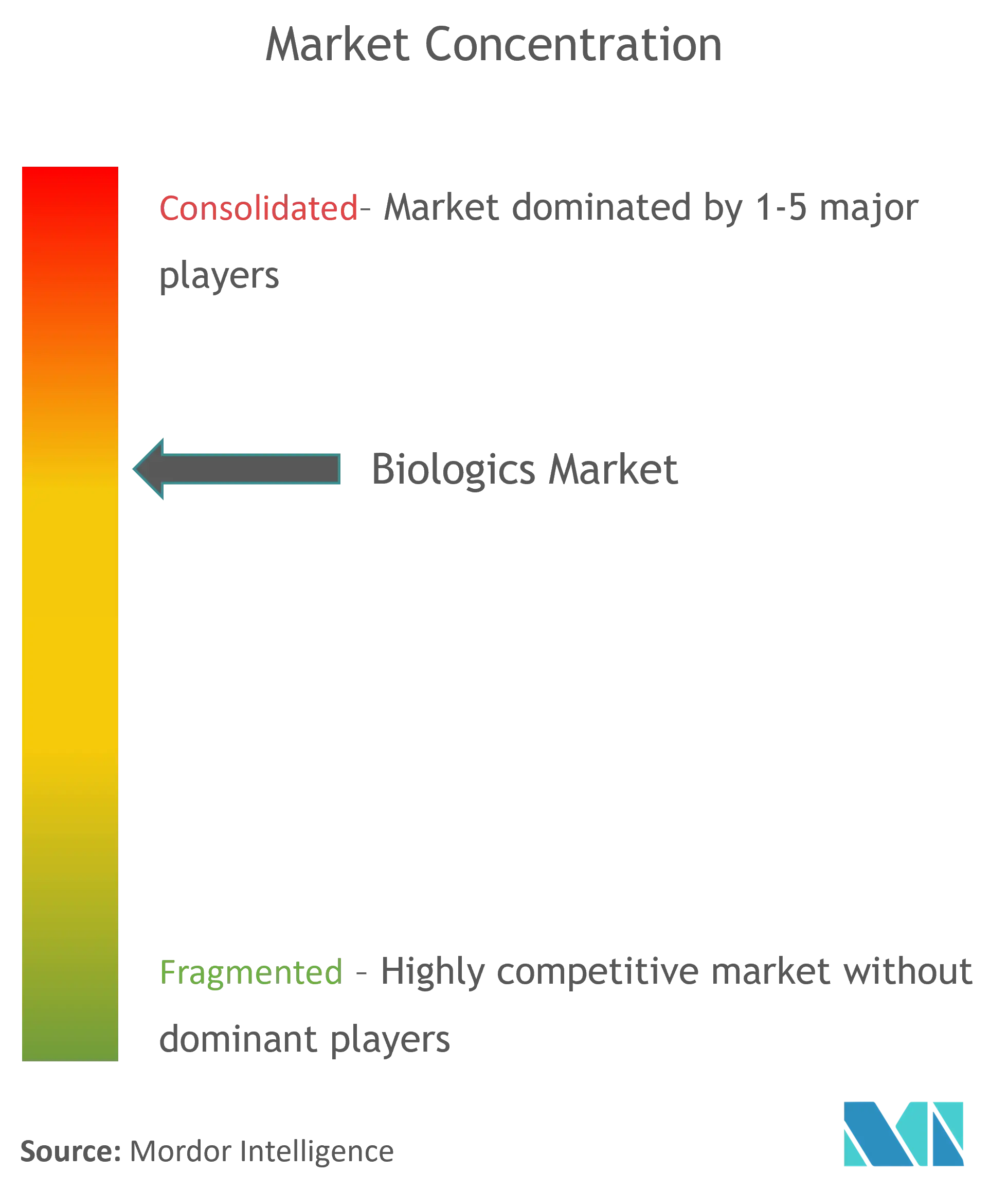
Biologics Market News
- In September 2023, Biogen Inc. received approval from the US Food and Drug Administration (FDA) for TOFIDENCE (tocilizumab-bavi) intravenous formulation. TOFIDENCE marks the pioneering approval of the tocilizumab biosimilar in the United States, signaling a significant advancement in treatment options for specified medical conditions.
- In June 2022, Aeglea BioTherapuetics announced that it had failed to secure a biologics license application (BLA) from the FDA after administrators issued a refusal to file for the company's biologic pegzilarginase.
- In February 2022, Janssen Pharmaceutical Companies of Johnson & Johnson received the United States Food and Drug Administration (FDA) approval for CARVYKTI (ciltacabtagene autoleucel; cilia-cel). This biologic medicine treats adults with relapsed or refractory multiple myeloma (RRMM) after four or more prior lines of therapy, including a proteasome inhibitor, an immunomodulatory agent, and an anti-CD38 monoclonal antibody.
Biologics Market Report - Table of Contents
1. INTRODUCTION
1.1 Study Assumptions and Market Definition
1.2 Scope of the Study
2. RESEARCH METHODOLOGY
3. EXECUTIVE SUMMARY
4. MARKET DYNAMICS
4.1 Market Overview
4.2 Market Drivers
4.2.1 Growing Capital Investment from Key Market Players
4.2.2 Rise in the Prevalence of Chronic Diseases
4.2.3 Growing Demand and Higher Acceptability for Innovative Therapies
4.3 Market Restraints
4.3.1 Stringent Regulatory Process and Initial High Capital Investment
4.3.2 Rising Control and Cost for Accessing Biologics
4.3.3 Loss of Patent Exclusivity of the Leading Biologic Drugs
4.4 Porter's Five Forces Analysis
4.4.1 Threat of New Entrants
4.4.2 Bargaining Power of Buyers/Consumers
4.4.3 Bargaining Power of Suppliers
4.4.4 Threat of Substitute Products
4.4.5 Intensity of Competitive Rivalry
5. MARKET SEGMENTATION (Market Size by Value - USD)
5.1 By Product
5.1.1 Monoclonal Antibodies
5.1.2 Vaccines
5.1.3 Recombinant Hormones/Proteins
5.1.4 Cellular-based Biologics
5.1.5 Gene-based Biologics
5.1.6 Other Products
5.2 By Application
5.2.1 Cancer
5.2.2 Infectious Diseases
5.2.3 Autoimmune Diseases
5.2.4 Other Applications
5.3 By Source
5.3.1 Microbial
5.3.2 Mammalian
5.4 By Geography
5.4.1 North America
5.4.1.1 United States
5.4.1.2 Canada
5.4.1.3 Mexico
5.4.2 Europe
5.4.2.1 Germany
5.4.2.2 United Kingdom
5.4.2.3 France
5.4.2.4 Italy
5.4.2.5 Spain
5.4.2.6 Rest of Europe
5.4.3 Asia-Pacific
5.4.3.1 China
5.4.3.2 Japan
5.4.3.3 India
5.4.3.4 Australia
5.4.3.5 South Korea
5.4.3.6 Rest of Asia-Pacific
5.4.4 Middle East and Africa
5.4.4.1 GCC
5.4.4.2 South Africa
5.4.4.3 Rest of Middle East and Africa
5.4.5 South America
5.4.5.1 Brazil
5.4.5.2 Argentina
5.4.5.3 Rest of South America
6. COMPETITIVE LANDSCAPE
6.1 Company Profiles
6.1.1 AbbVie Inc.
6.1.2 Amgen Inc.
6.1.3 Eli Lilly and Company
6.1.4 F. Hoffmann-La Roche AG
6.1.5 GlaxoSmithKline PLC
6.1.6 Johnson & Johnson
6.1.7 Merck & Co.
6.1.8 Pfizer Inc.
6.1.9 Sanofi SA
6.1.10 Bristol Myers Squibb
6.1.11 AstraZeneca PLC
6.1.12 Novartis AG
- *List Not Exhaustive
7. MARKET OPPORTUNITIES AND FUTURE TRENDS
Biologics Industry Segmentation
The term "biologics" refers to large, complex molecules made in living cells grown in a laboratory. Biologic medicines are often 200 to 1,000 times the size of a small molecule or chemical drug. Due to their large molecular size and fragile molecular structure, biologics are majorly delivered through parenteral routes.
The biologics industry report is segmented by product, application, source, and geography. The product is further segmented into monoclonal antibodies, vaccines, recombinant hormones/proteins, cellular-based biologics, gene-based biologics, and other products. The application is divided into cancer, infectious, autoimmune, and other applications. The source is further bifurcated into microbial and mammalian. Geography segmented is further divided into North America, Europe, Asia-Pacific, Middle East and Africa, and South America. The biologics report also covers the estimated market size and trends for 17 countries across major global regions. The report offers the biologics market size and forecasts in value in USD for all the above-mentioned segments.
| By Product | |
| Monoclonal Antibodies | |
| Vaccines | |
| Recombinant Hormones/Proteins | |
| Cellular-based Biologics | |
| Gene-based Biologics | |
| Other Products |
| By Application | |
| Cancer | |
| Infectious Diseases | |
| Autoimmune Diseases | |
| Other Applications |
| By Source | |
| Microbial | |
| Mammalian |
| By Geography | ||||||||
| ||||||||
| ||||||||
| ||||||||
| ||||||||
|
Biologics Market Research FAQs
How big is the Biologics Market?
The Biologics Market size is expected to reach USD 373.5 billion in 2024 and grow at a CAGR of 10.49% to reach USD 615 billion by 2029.
What is the current Biologics Market size?
In 2024, the Biologics Market size is expected to reach USD 373.5 billion.
Who are the key players in Biologics Market?
Amgen, Inc., Eli Lilly and Company, GlaxoSmithKline PLC, Abbvie Inc. and F. Hoffmann- La Roche AG are the major companies operating in the Biologics Market.
Which is the fastest growing region in Biologics Market?
Asia Pacific is estimated to grow at the highest CAGR over the forecast period (2024-2029).
Which region has the biggest share in Biologics Market?
In 2024, the North America accounts for the largest market share in Biologics Market.
What years does this Biologics Market cover, and what was the market size in 2023?
In 2023, the Biologics Market size was estimated at USD 334.32 billion. The report covers the Biologics Market historical market size for years: 2019, 2020, 2021, 2022 and 2023. The report also forecasts the Biologics Market size for years: 2024, 2025, 2026, 2027, 2028 and 2029.
What are the key factors driving the Biologics Market?
The Biologics Market is driven by a) Rise in the prevalence of chronic diseases b) Growing demand and higher acceptability for innovative therapies, c) Loss of patent exclusivity of the leading biologic drugs
Biologic Therapy Industry Report
This comprehensive report offers a deep dive into the biologics industry, providing a detailed analysis of key market drivers and market segments. Mordor Intelligence offers customization based on your specific interests, including: 1. Devices: Syringes, Pens, and Pumps 2. Product: Antisense, RNAi & Molecular Therapy 3. Application: Oncology, Immunological Disorders, Cardiovascular Disorders, and Hematological Disorders 4. Source: Microbial, Mammalian

